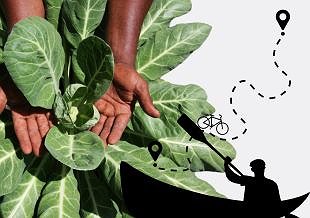Learn A River's Name
In 2017, Akiko Busch wrote an op-ed in The New York Times about a trip she took across the country. The article titled, “Learn a River’s Name Before It’s Gone” describes the author’s attempt to document every body of water she crossed along the way. The author admits she was unable to jot down every stream and creek he crossed, but her piece has a deeper meaning. Learning a person’s name is the first step in getting to know them, and when you learn a river’s name, it becomes a lot easier to protect it.
Mare Liberum's punt will be painted and on display during the exhibition
Photo by Caleb Eckert
That is the idea behind the Schuylkill Center for Environmental Education’s (SCEE) new art exhibition titled “Learn a River’s Name.” This curated group exhibition opens January 25, and features seven artists whose work is inspired by watersheds and how humans have interacted with them over centuries. Each project dives into the unique characteristics of a river, with a focus on the Delaware, Schuylkill, Brandywine and Hudson Rivers.
Camp Little Hope's installation at Glenn Foerd Mansion shows how rising sea levels will effect Philly neighborhoods
Photo by Camp Little Hope
“They’re rivers that are familiar to people, but maybe not in a way that is as deep or as meaningful as it might be,” said Christina Catanese, Director of Environmental Art at SCEE. “All the artists are revealing things about the river systems in a way that encourages us to know them a little more deeply.”
Chloe Wang Paints the Schuylkill River--Photo By SCEE
According to Catanese, the artists immersed themselves in their chosen watershed in order to complete their projects. “Something we are trying to show in this gallery show is not just the final outcome of an artist’s relationship with the rivers, but the process behind that,” Catanese said. “How they came to know the river and understand it, not just the beautiful final product of the investigation.”
Dylan Gauthier is one of the artists and his project comes from a year long residency at the Brandywine Conservancy and Museum of Art. He used a hand made boat to travel down the Brandywine to the Christina River and the Delaware Bay. Gauthier creates alternative maps of the river, and documented his journey through video. Portions will be displayed as part of the exhibit.
Another interesting project was created by artist Sandy Sorlien, who documented the nearly 200 year old Schuylkill Navigation System. Her project examines the history and future of the remaining canal and towpaths.
“Towpaths are lovely places for walking, running, and sightseeing because you can see waterways on both sides, even if the canal is only stormwater, and they're flat,” Sorlien said. “The Schuylkill water quality is so much better than it used to be, and more than fifty species of fish have returned since that cleanup and dismantling of numerous dams. I've seen bald eagles, osprey, herons, mergansers, and a mink swimming across the river.”
Artist Matthew Friday has been active in promoting environmental education there for the past 10 years. His project focuses on the Hudson Valley watershed, and protecting this river with community engagement and public projects.
Friday believes teaching people to use and enjoy their watershed is a critical step in protecting any river. His project is a culmination of group kayaking and canoe trips, and walks along the trails that follow the creeks feeding into the Hudson River. He created maps and diagrams from these trips, and Friday submitted proposals to the municipal authorities on sustainable ways to use the watershed.
Artist Matthew Friday--Photo By SCEE
“One of the things I’ve been particularly interested in is not just educating people about their watersheds and their dynamics, but also getting people out on their watersheds to actually participate and enjoy them,” Friday said. “That becomes one of the critical steps in getting people to really care about their ecologies.”
Friday used the information he gathered over the past 10 years of working with communities in the Hudson Valley to create diagrams to understand the dynamic and characteristics of the watershed. These diagrams are on display in the exhibit, and were made with sustainable materials including paper made from water chestnuts, and pigments and dyes from alongside the river. Friday uses algae dye, sumac dye, and he even created a dye from toxic mud he collected from a dredging site.
“There’s one really big painting that’s actually a CNC routed topographical map of the Hudson River watershed that’s made with a pigment that was milled from the polychlorinated biphenyl pollutants that GE pumped into the river since the 1970s,” Friday said. “I was able to sneak on to their dredging site and get a bunch of this really super toxic carcinogenic mud, and mill it down into a pygment.”
Matthew Friday's works exmine the Hudson Valley--Photo By SCEE
Friday believes the mindset and approach to documenting these rivers can be applied to any watershed. “The process of engaging people with their watersheds, and thinking about the system as a whole is really something that can be done in any watershed, it has relevance across geography,” Catanese said. “We rely on water as it’s essential to life, and yet as a system we aren’t always aware of all the factors going into providing clean water for us to use.”
Friday hopes people find a connection to their own watersheds from his work. “I think it’s really important for people to understand all the nuances of the ecosystem. It’s crucial to understand that we are part of our watersheds,” Friday said. “When we left the oceans millions of years ago we did it by encapsulating water in bodies and bringing it with us. We are our own little watersheds that are moving around that are existing within larger watersheds.”


